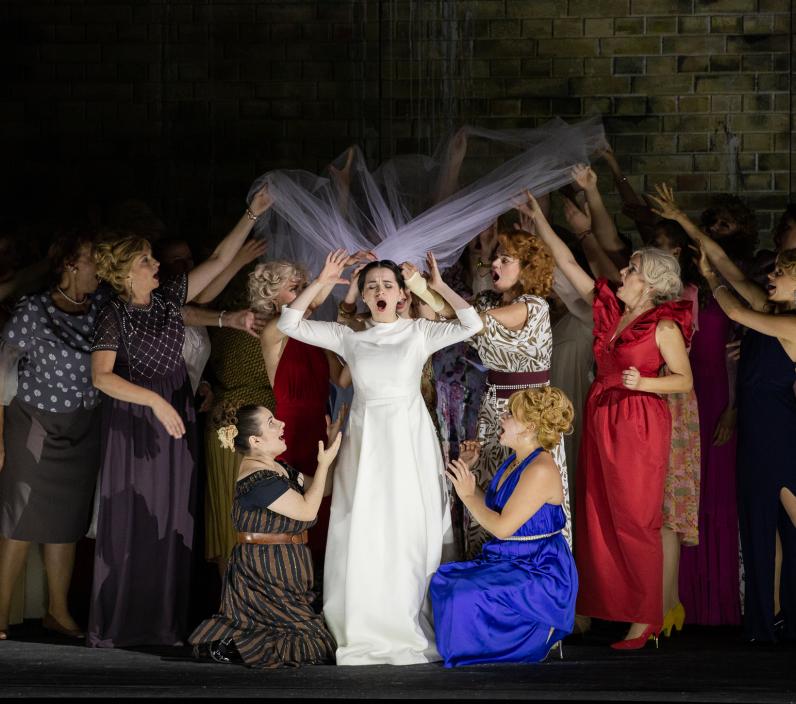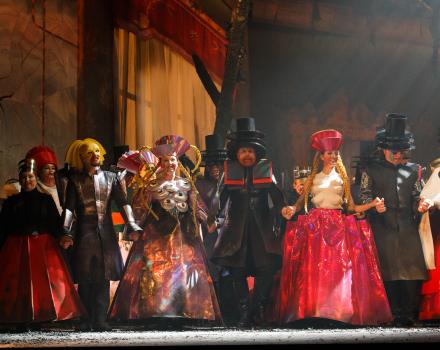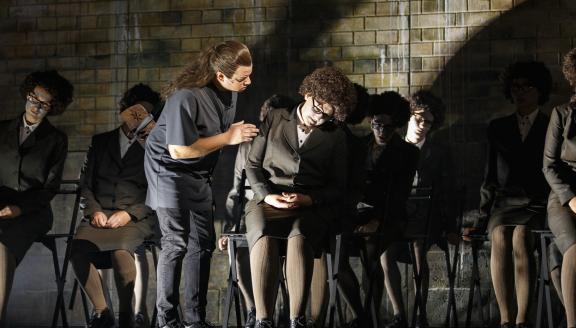

I Played, I Danced

A wedding goes awry when the venue catches fire and the bride is dragged into the underworld. Only a kokle player is brave enough – and musical enough – to venture there and save her.
With its mummers, imps, three-headed demon king and singing mole cricket, I Played, I Danced is a story like none other. Composed in 1977, Imants Kalniņš’s elaborate musical language is blended with Latvian folk to create a unique and moving soundworld. Leading young Latvian director Laura Groza-Ķibere and visual artist Miķelis Fišers bring out the wild energy of this opera in their new production that forces us to ask: How much should we fight the demons of the past while striving for a better future?
Cast
|
Tots
|
Raimonds Bramanis
|
|---|---|
|
Lelde
|
Marlēna Keine
|
|
Three-headed Demon King
|
Jānis Apeinis
|
|
Lord
|
Krišjānis Norvelis
|
|
The Blind Man
|
Rihards Mačanovskis
|
|
Witch
|
Ilona Bagele
|
|
The Lame Man
|
Rinalds Kandalincevs
|
|
Zemgus
|
Juris Ādamsons
|
|
Mole Cricket
|
Laura Grecka
|
|
Lelde’s Mother
|
Evija Martinsone
|
|
Zemgus’ Mother
|
Andžella Goba
|
|
Foreman
|
Guntars Ruņģis
|
|
Imp
|
Mihails Čuļpajevs
|
|
Pegleg
|
Kalvis Kalniņš
|
| ... | |
|
Music
|
Imants Kalniņš
|
|---|---|
|
Conductor
|
Mārtiņš Ozoliņš
|
|
Director
|
Laura Groza-Ķibere
|
|
Sets
|
Miķelis Fišers
|
|
Lighting
|
Oskars Pauliņš
|
|
Costumes
|
Kristīne Pasternaka
|
|
Text
|
Imants Ziedonis, after a play by Rainis
|
| ... | |
Video
The story
Act I
The wedding of Zemgus and Lelde is about to be celebrated by the Riga Castle on the Daugava Embankment. Suddenly some mummers appear uninvited – the musician Tots, the Witch, the Blind Man, and the Lame Man. Tots sings, and his song rouses a sense of freedom and love of life that Lelde has not known before. When she looks into the future, the Witch sees a threat to Lelde. During the wedding ceremony, the old Lord arrives unseen and steals three drops of blood from Lelde. The strings snap on Tots’s kokle – a traditional Latvian zither – and a fire engulfs the castle.
Zemgus mourns Lelde’s death. Tots, who also mourns her, demands of Mother Earth to return the girl to life. The Mole Cricket appears and speaks on behalf of Mother Earth. He brings a message about the power of song to fight evil. In support of Tots’s quest, he gives him a root to replace the broken strings. Tots hears the voices of the dead. They plead with him to fight for them as well as for Lelde, for their peace and remembrance is disturbed by suffering visited on them by devils. Tots is told that Lelde can be restored to life with the help of the candle-of-the-dead and the three drops of blood stolen by the Lord.
Act II
Tots arrives at the Ambassadors’ Hall in Riga Castle and finds the Lord drunk on Lelde’s blood. Pretending to be one of the dead, he and the Lord wake up the devils that have moved into the Castle. Tots entertains the devils and the witches with his sharp tongue and is rewarded with a devil’s tail to use as a string for his kokle. His instrument is gaining an ever richer sound that combines two different worlds.
Tots finds Lelde. She is weak but not yet fully in devils’ power, since it is only her first night in the underworld. Lelde gives him her hair for a string. Tots promises to fix up a wedding for the Lord and Lelde so that he can steal back her drops of blood. Fascinated by Tots’s antics, the devils and witches tear out the Lord’s vein for Tots’s kokle and steal back the three drops of blood themselves, which are spilled and seep into the ground.
Tots’s song moves the three-headed Demon King, who sees in Tots his long-lost son. He offers the musician to inherit the devils’ realm but Tots refuses. He professes his ambition to instead unite the nether regions of the world with the higher ones. Tots calls for the help of the dead, who give him the candle-of-the-dead. With it, he fights and conquers the devils, driving them off. Tots can now revive Lelde, yet the candle was not given to him only for saving Lelde – he must bring the remembrance of the dead to the present and into the future.
Act III
As dawn breaks, reconstruction work begins at the castle. The mummers tell the story of what took place during the night. Tots brings Lelde over and lights the candle, the flame of which must touch the sunlight in order for the dead to rest in peace and for Lelde to revive. The sun rises and the dead thank Tots and depart. But Lelde cannot wake up, for Mother Earth and the dead have taken the spilled blood for themselves.
For Lelde to live, someone has to sacrifice himself. When Zemgus fails to do so, Tots musters all his willpower and gives Lelde his blood. Lelde revives and takes over Tots’s song as he dies. The Mole Cricket announces that he is a saint and thus will continue to live within everyone.
Insights
5 things to know about I Played, I Danced
1° Rainis – poet and politician
The play I Played, I Danced was written during the First World War. Its author, the poet and playwright Rainis (1865 – 1929) is considered the most influential figure in Latvian literature and even called the ‘Latvian Goethe’. Also hailed as the father of Latvian socialism, Rainis was arrested and deported in 1897 for calling for social reforms. Having played an instrumental role in the failed 1905 revolution, Rainis had to emigrate to Switzerland.
In the wake of the First World War, Rainis placed his dramatic art at the service of his compatriots, combining characters of Latvian mythology with the political issues of his time. In I Played, I Danced, he evoked Latvia’s occupation by dramatizing the resurrection of the ‘Lord’, who suppresses the Latvian people. The central character Tots takes an orphic plunge into the underworld to bring back the bride Lelde – symbolizing Latvia – from the grip of death.
2° The days of Imants
Considered to be a symbol of the Latvian anti-establishment art scene, the versatile composer Imants Kalniņš is as popular as he is subversive. A festival devoted to his music, entitled ‘The days of Imants’, was outright banned by the Soviet state. Despite having studied classical music, Kalniņš became famous as a rock musician and composer of the first rock opera in the USSR, Hey, you there!. During the 1970s, he returned to writing symphonic music again.
In 1977, Kalniņš set the play I Played, I Danced to music. In the opera, spectators can hear folkloristic reminiscences of Latvian traditional music blended into Kalniņš’s ornamental and elaborate musical language. Latvian music magazine Mūzikas Saule calls the opera ‘the master’s most magnificent work’.
3° Updating the opera for a contemporary audience
Leading young Latvian director Laura Groza-Ķibere brings out the wild energy of the opera in the Latvian National Opera and Ballet’s production and raises many questions. Are Rainis’s ideas still relevant today? Should one fight the demons of the past to enliven a new vision for the future?
Groza-Ķibere is determined to find a contemporary analogy: ‘When Rainis wrote this play during the war, he could not have imagined that Latvia would ever be free, although he dreamed it and encoded it in the image of Lelde. In the 1970s, Imants Kalniņš and the librettist Imants Ziedonis discussed the same thing. It was quite clear who the external enemy was, that the country was finally ours, despite its occupation.’
4° Hell is a radically national environment
Given the opera’s subtext of the Latvian fight for independence, the production’s departure from the accepted national symbolism strikes as controversial. Nonetheless, the director claims that Kalniņš’s vision is not stuck in national categories, merely employing the Latvian symbolism. Rainis himself wanted to build a new country using the experience gained in exile instead of closing down the borders.
‘That's why hell is defined in our show as a radically national environment.’ says Groza-Ķibere, ‘It would be a hell for me – as a Latvian citizen and patriot – to come to a country where borders would be closed and nationalized, where everyone would be singing at the famous Latvian Song and Dance Festival, wearing a garter and representing a singular point of view.’ The production can be seen as a powerful critique of the impossible quest for authenticity. In Act II, in particular, it showcases the irony of commodifying folklore.
5° Riga Castle is burning
At the beginning of Act I, the set of I Played, I Danced is overshadowed by the walls of Riga Castle. During the wedding ceremony, the strings of Tots’s kokle break and a fire breaks out engulfing the castle. For a Latvian audience, the events on stage inevitably call back vivid memories of the fire that erupted on the night of the summer solstice in 2013. Like the fire of the cathedral Notre-Dame de Paris, it broke out during renovation work.
The production depicts how negligent society has become in the safeguarding of its reclaimed heritage. Mirroring real life, in Act III, reconstruction work has begun and mummers recount the previous night’s events. ‘At a time when no one is threatening us, in the very heart of Old Riga, the symbol of Riga burned down the evidence of our country's national history that identifies us as a nation’ affirms Groza-Ķibere.
Gallery
















